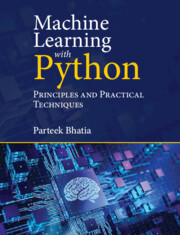Refine search
Actions for selected content:
2327 results in Pattern Recognition and Machine Learning
6 - Engineering Implementations in Deep Learning Recommender Systems
-
- Book:
- Deep Learning Recommender Systems
- Published online:
- 08 May 2025
- Print publication:
- 22 May 2025, pp 191-224
-
- Chapter
- Export citation

Scalable Monte Carlo for Bayesian Learning
-
- Published online:
- 16 May 2025
- Print publication:
- 05 June 2025

Deep Learning Recommender Systems
-
- Published online:
- 08 May 2025
- Print publication:
- 22 May 2025

Machine Learning with Python
- Principles and Practical Techniques
-
- Published online:
- 22 February 2025
- Print publication:
- 31 December 2025
-
- Textbook
- Export citation
Appendix B - Advanced Topics in Classification Metrics
- from Appendices
-
- Book:
- Machine Learning Evaluation
- Published online:
- 07 November 2024
- Print publication:
- 21 November 2024, pp 373-386
-
- Chapter
- Export citation
Contents
-
- Book:
- Machine Learning Evaluation
- Published online:
- 07 November 2024
- Print publication:
- 21 November 2024, pp vii-x
-
- Chapter
- Export citation
12 - Conclusion
- from Part IV - Evaluation from a Practical Perspective
-
- Book:
- Machine Learning Evaluation
- Published online:
- 07 November 2024
- Print publication:
- 21 November 2024, pp 342-358
-
- Chapter
- Export citation
Appendices
-
- Book:
- Machine Learning Evaluation
- Published online:
- 07 November 2024
- Print publication:
- 21 November 2024, pp 359-360
-
- Chapter
- Export citation
Dedication
-
- Book:
- Machine Learning Evaluation
- Published online:
- 07 November 2024
- Print publication:
- 21 November 2024, pp v-vi
-
- Chapter
- Export citation
Index
-
- Book:
- Machine Learning Evaluation
- Published online:
- 07 November 2024
- Print publication:
- 21 November 2024, pp 403-408
-
- Chapter
- Export citation
Acknowledgments
-
- Book:
- Machine Learning Evaluation
- Published online:
- 07 November 2024
- Print publication:
- 21 November 2024, pp xvii-xviii
-
- Chapter
- Export citation
4 - Traditional Machine Learning Evaluation
- from Part I - Preliminary Considerations
-
- Book:
- Machine Learning Evaluation
- Published online:
- 07 November 2024
- Print publication:
- 21 November 2024, pp 51-80
-
- Chapter
- Export citation
Part III - Evaluation for Other Settings
-
- Book:
- Machine Learning Evaluation
- Published online:
- 07 November 2024
- Print publication:
- 21 November 2024, pp 209-210
-
- Chapter
- Export citation
6 - Resampling
- from Part II - Evaluation for Classification
-
- Book:
- Machine Learning Evaluation
- Published online:
- 07 November 2024
- Print publication:
- 21 November 2024, pp 128-153
-
- Chapter
- Export citation
2 - Statistics Overview
- from Part I - Preliminary Considerations
-
- Book:
- Machine Learning Evaluation
- Published online:
- 07 November 2024
- Print publication:
- 21 November 2024, pp 8-32
-
- Chapter
- Export citation
Part I - Preliminary Considerations
-
- Book:
- Machine Learning Evaluation
- Published online:
- 07 November 2024
- Print publication:
- 21 November 2024, pp 1-2
-
- Chapter
- Export citation
Appendix A - Statistical Tables
- from Appendices
-
- Book:
- Machine Learning Evaluation
- Published online:
- 07 November 2024
- Print publication:
- 21 November 2024, pp 361-372
-
- Chapter
- Export citation
Preface
-
- Book:
- Machine Learning Evaluation
- Published online:
- 07 November 2024
- Print publication:
- 21 November 2024, pp xv-xvi
-
- Chapter
- Export citation
Abbreviations
-
- Book:
- Machine Learning Evaluation
- Published online:
- 07 November 2024
- Print publication:
- 21 November 2024, pp xi-xiv
-
- Chapter
- Export citation
10 - Industrial-Strength Evaluation
- from Part IV - Evaluation from a Practical Perspective
-
- Book:
- Machine Learning Evaluation
- Published online:
- 07 November 2024
- Print publication:
- 21 November 2024, pp 289-307
-
- Chapter
- Export citation
